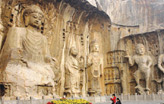Cars
Volkswagen's old platforms adapt to new realities
Updated: 2011-03-14 13:57
By Marvin Zhu (China Daily)
Updated generations of aging models continue to make best-seller list
Volkswagen has an enviable position in China's modern automotive history - it was the first global brand to enter the country and it did so when other automakers considered that a risky move.
|
|
Soon after setting up its first joint venture in Shanghai in 1985, followed by a second with Changchun-based FAW in 1991, Volkswagen became a top seller.
In the late 1970s, China identified the automotive industry as the potential engine for economic growth and opened up investment opportunities to attract global automotive powerhouses.
Most of them, including GM, Ford, Toyota, Nissan and PSA, showed little interest as they saw more risks than rewards in doing business in China.
It was Volkswagen that took the chance and drove into vast but undeveloped market.
Today it remains an important player in what became the world's biggest car market. But it is no longer the dominant leader.
Older generations Chinese grew up with the VW Santana and Jetta and came to think of them prototypes for what a saloon car should be.
That might explain why Chinese tend to prefer sedans to hatchbacks, wagons, MPVs and SUVs, which have become popular only recently.
For them, the Volkswagen brand was synonymous with quality and advanced technology. No other car brand in China earned as high customer loyalty.
Top seller status
The German carmaker had more than 90 percent of the car market in the 1990s.
With the two joint ventures with the highest capacity, the largest number of dealerships and the widest range of models covering almost every segment, Volkswagen had a monopoly over the Chinese market for some three decades.
It found little challenge to its top-seller status. In one of his interviews, retired former CEO of the VW Group, Bernd Pischetsrieder, said: "Yes, we have been number one in China, and we will always be the number one if we want."
Yet competition has become increasingly fierce and Volkswagen saw its share shrink to 12.7 percent in 2010 after losing 2 percent to its rivals over the previous three years.
Facing that competition in the fast growing market, Volkswagen is now on the defensive, relying on aging models in a market that is increasingly mature and selective.
| ||||
VW does have all-new models - the Golf, Sagitar, Tiguan, Magotan and CC - but it was the old-platform models that contributed the most to Volkswagen's China sales in 2010.
Only 23 percent of its sales were new models, so it would seem to make sense for Volkswagen to keep their aging fleet on the market.
Many a facelift of the Jetta or the Passat variant Santana have been launched in the past 20 years. The two models still make it onto the best-sellers list.
The coexistence of multiple-generations - such as the Jetta along with its variants Bora and Sagitar - is a popular strategy in the market today.
The approach could also be the result of a lesson Volkswagen learned early last decade - that "excess technology" can actually hamper sales.
When the Polo was launched by Shanghai VW in 2002 with state-of-the-art product features and manufacturing technologies, sales were sluggish due to the higher price.
FAW-VW's Magotan had a similar story. That was enough to convince the German carmaker that the market does not necessarily want newer platforms or stronger engines but the best fit for the local taste.
Hence VW has focused its product strategy on more utilization of mature platforms.
Volkswagen is realistic when it comes to sales, but that comes at the expense of competitiveness.
New offers from rivals
Longer intervals between two generations do not help when its rivals are wasting no time narrowing the generation gap and offering the latest in automotive technology.
GM has produced the new Buick Regal, Lacrosse, Excelle XT/GT and Chevrolet Cruze on the latest global platforms with state-of-the-art engines.
Hyundai and Kia both introduced a number of contemporary models in China at the same time as it did in other markets.
Even PSA Peugeot Citroen, often criticized for not bringing in new offers to China, added the latest C5 and 508 to its local product mix. No wonder they keep eating into Volkswagen's shares.
However, it appears that VW is not going to change its strategy.
Despite a facelift at the end of 2010, plans to revamp both the Jetta and Santana and a new local brand to be built at a future plant in Guangdong province, Volkswagen will be encouraged to continue focusing on old platforms and aging designs - making models that bring high sales volumes.
The author is a senior analyst of JD Power and Associates.
E-paper

Rise and shine
The Chinese solar energy industry is heating up following recent setbacks in the nuclear sector
Bombs aim for regime change
CSI, with a twist
Literary path
Specials

Peony express
Growers of china's unofficial national flower are reaching out to europe for help

Tea-ing up
More turning to Chinese tea for investment opportunities like vintage wine

A cut above
The ancient city of Luoyang is home to a treasure trove of cultural wonders.





